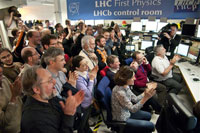Beams collided at 7 TeV in the LHC at 13:06 CEST on 30th March, marking the start of the LHC research programme
European Organization for Nuclear Research (CERN)

- © CERN
“It’s a great day to be a particle physicist,” said CERN, Director General Rolf Heuer. “A lot of people have waited a long time for this moment, but their patience and dedication is starting to pay dividends.”
“With these record-shattering collision energies, the LHC experiments are propelled into a vast region to explore, and the hunt begins for dark matter, new forces, new dimensions and the Higgs boson,” said ATLAS collaboration spokesperson, Fabiola Gianotti. “The fact that the experiments have published papers already on the basis of last year’s data bodes very well for this first physics run.”
“We’ve all been impressed with the way the LHC has performed so far,” said Guido Tonelli, spokesperson of the CMS experiment, “and it’s particularly gratifying to see how well our particle detectors are working while our physics teams worldwide are already analysing data. We’ll address soon some of the major puzzles of modern physics like the origin of mass, the grand unification of forces and the presence of abundant dark matter in the universe. I expect very exciting times in front of us.”
CERN will run the LHC for 18-24 months with the objective of delivering enough data to the experiments to make significant advances across a wide range of physics channels.
“The Large Hadron Collider (LHC) has a real chance over the next two years of discovering supersymmetric particles,” explained Heuer, “and possibly giving insights into the composition of about a quarter of the Universe.”
Note: CERN, the European Organization for Nuclear Research, is the world's leading laboratory for particle physics. It has its headquarters in Geneva. At present, its Member States are Austria, Belgium, Bulgaria, the Czech Republic, Denmark, Finland, France, Germany, Greece, Hungary, Italy, Netherlands, Norway, Poland, Portugal, Slovakia, Spain, Sweden, Switzerland and the United Kingdom. India, Israel, Japan, the Russian Federation, the United States of America, Turkey, the European Commission and UNESCO have Observer status.
Related links:
:: First attempt at 7 TeV collissions in CERN's LHC scheduled for 30 March 2010 (More)
:: Our understanding of the Universe is about to change... (More)
- Source:CERN
- 30-03-2010

